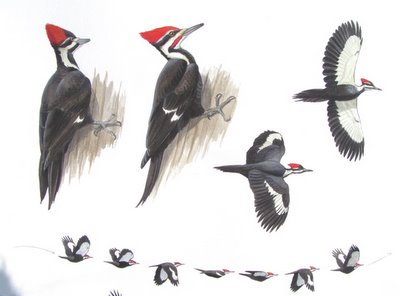 Part of a plate painted for "Very Large Woodpeckers," an article I wrote for Bird Watcher's Digest.
Part of a plate painted for "Very Large Woodpeckers," an article I wrote for Bird Watcher's Digest.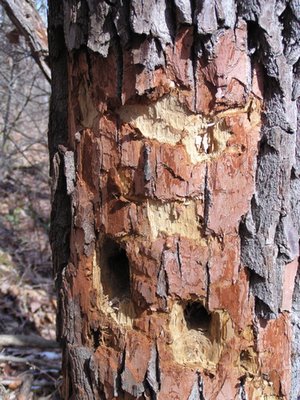 Over the last few months, I've been building a gallery of woodpecker art: art by woodpeckers. There's something going on with carpenter ants and sassafras trees in late winter; I'm not sure what it is, but our larger sassies are under full assault by pileated woodpeckers, with spectactular effects. A sassafras whose bark has just been scaled off has a bright cinnabar wound, that turns to gray within a few weeks.This one, below, is an older working--the red bark has grayed.
Over the last few months, I've been building a gallery of woodpecker art: art by woodpeckers. There's something going on with carpenter ants and sassafras trees in late winter; I'm not sure what it is, but our larger sassies are under full assault by pileated woodpeckers, with spectactular effects. A sassafras whose bark has just been scaled off has a bright cinnabar wound, that turns to gray within a few weeks.This one, below, is an older working--the red bark has grayed.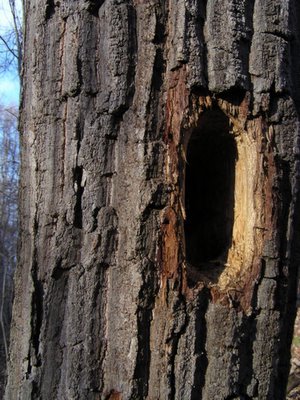 Other clues tell me how fresh the work is: the condition and color of the chips below, and particularly that of any droppings amid the chips. This is a minute-old dropping.It's mostly sumac, smilax and other fruits.
Other clues tell me how fresh the work is: the condition and color of the chips below, and particularly that of any droppings amid the chips. This is a minute-old dropping.It's mostly sumac, smilax and other fruits.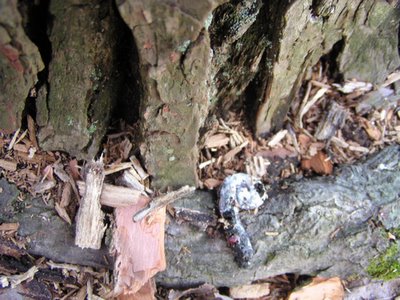
And here are some droppings under the same tree, but a month later, also very fresh, and composed almost entirely of carpenter ant exoskeletons:
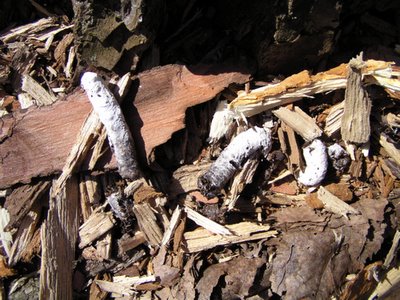 Just for scale, my hand. Note how all these holes have the pileated's rectangular trademark. Interestingly, the nest cavity is almost always round. I don't know why their workings are rectangular, but perhaps that shape allows them maximum access to the punky heartwood and the galleries of beetles and ants that they're striving to reach.
Just for scale, my hand. Note how all these holes have the pileated's rectangular trademark. Interestingly, the nest cavity is almost always round. I don't know why their workings are rectangular, but perhaps that shape allows them maximum access to the punky heartwood and the galleries of beetles and ants that they're striving to reach.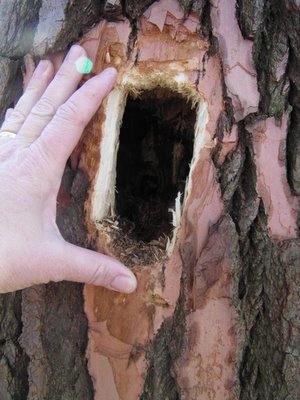 These are BIG holes, 3" x 6". Here's the same hole, a month later--much enlarged!
These are BIG holes, 3" x 6". Here's the same hole, a month later--much enlarged!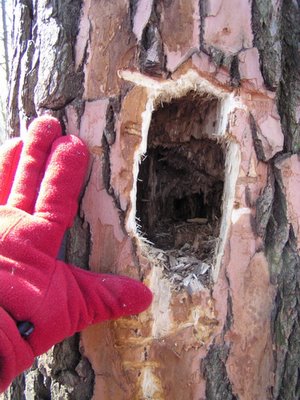
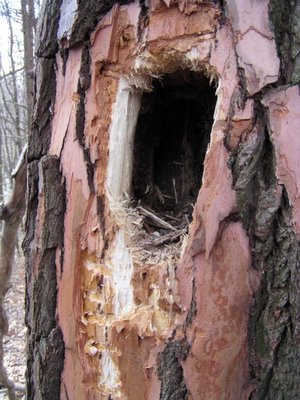 The power of a pileated's bill amazes me. Below is a closeup of the individual bill strikes on the same tree shown above. You can see the path of each blow, ending with a dark hole on the left border of the bark. It almost looks like the track of a bullet. This kind of sideways blow pops the thick bark off--a technique favored by ivory-billed woodpeckers.
The power of a pileated's bill amazes me. Below is a closeup of the individual bill strikes on the same tree shown above. You can see the path of each blow, ending with a dark hole on the left border of the bark. It almost looks like the track of a bullet. This kind of sideways blow pops the thick bark off--a technique favored by ivory-billed woodpeckers.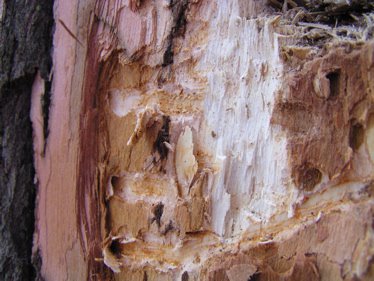
I'll come up to a tree that's just riddled with holes and chopmarks, thinking, "That must be pretty punky wood for a bird to do that much damage." Such was the case with this American beech.
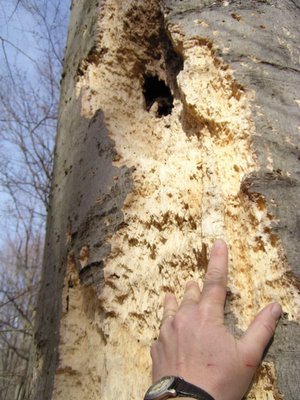 And I was dumbfounded to find I couldn't so much as flake a piece off with my fingernails. This was solid, living wood, and a bird weighing maybe 10 ounces had chopped it to bits.
And I was dumbfounded to find I couldn't so much as flake a piece off with my fingernails. This was solid, living wood, and a bird weighing maybe 10 ounces had chopped it to bits.Here's one of the things they're after. A larva of a wood-boring beetle, perhaps a cerambycid of the type ivory-billed woodpeckers devour, started its journey on the lower left of this trunk. See how the tunnel darkens and widens as it comes into the shepherd's crook? Here, the larva entered another instar, molted its exoskeleton and emerged a size larger. The tunnel widens again at the bottom of the crook--perhaps another molt. And you can see it getting larger as it moves up the tree. There's a sharp left hook, and another molt/instar. Thanks to Martha Weiss for teaching me how to read larval tunnels. And now you know how.
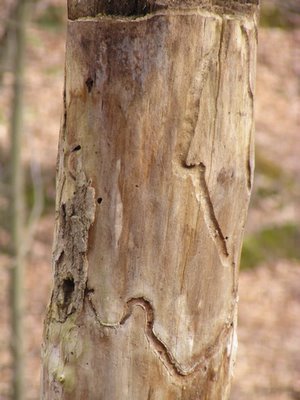 By now this thing is the size of a crinkle-cut fry, and quite a prize for a woodpecker. Pileated woodpeckers peeled the bark off this tree, and dug several large rectangular holes in it, looking for just such treasures.
By now this thing is the size of a crinkle-cut fry, and quite a prize for a woodpecker. Pileated woodpeckers peeled the bark off this tree, and dug several large rectangular holes in it, looking for just such treasures.Guided by the patches of fresh red or white inner bark, I go from one pileated dig to another all through the 250-acre woods I haunt.
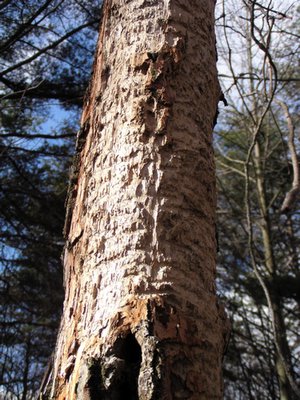 There are three, perhaps four pairs of pileated woodpeckers who also call this woodland home. They've got everything they need: lots of standing live and dead timber, borders full of sumac and dogwood, smilax and poison ivy; running water, places to roost and nest. I never walk the woods without hearing or seeing at least two. One day I saw seven. And I never see a pileated woodpecker without giving thanks that this bird is still common, and plans to stay that way.
There are three, perhaps four pairs of pileated woodpeckers who also call this woodland home. They've got everything they need: lots of standing live and dead timber, borders full of sumac and dogwood, smilax and poison ivy; running water, places to roost and nest. I never walk the woods without hearing or seeing at least two. One day I saw seven. And I never see a pileated woodpecker without giving thanks that this bird is still common, and plans to stay that way.






0 comments:
Post a Comment